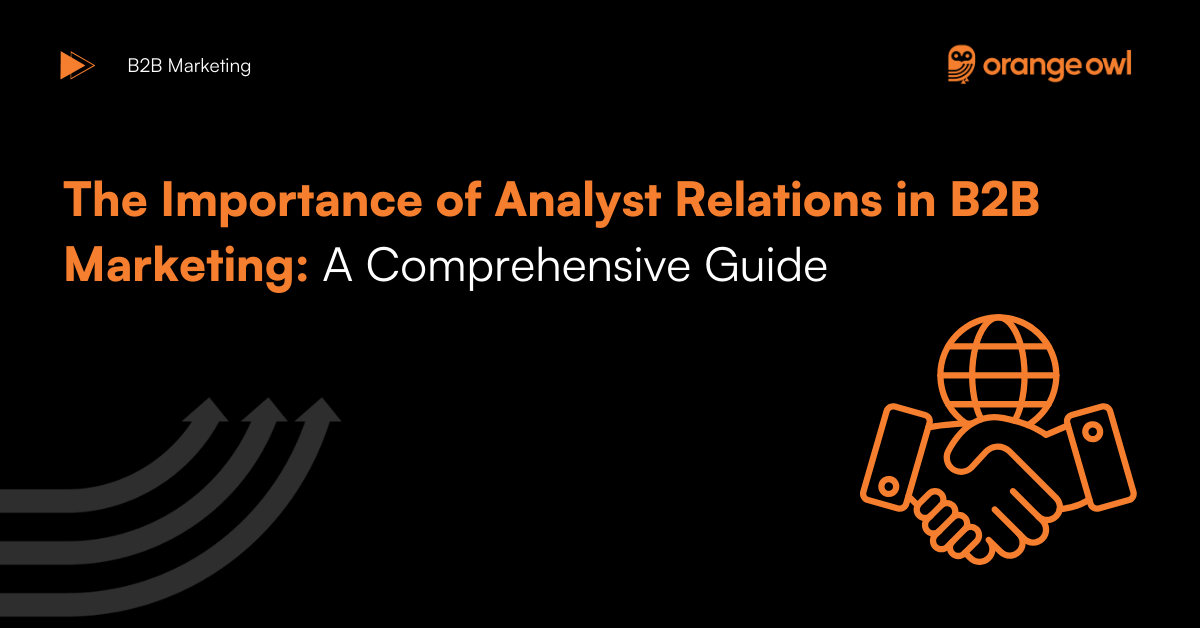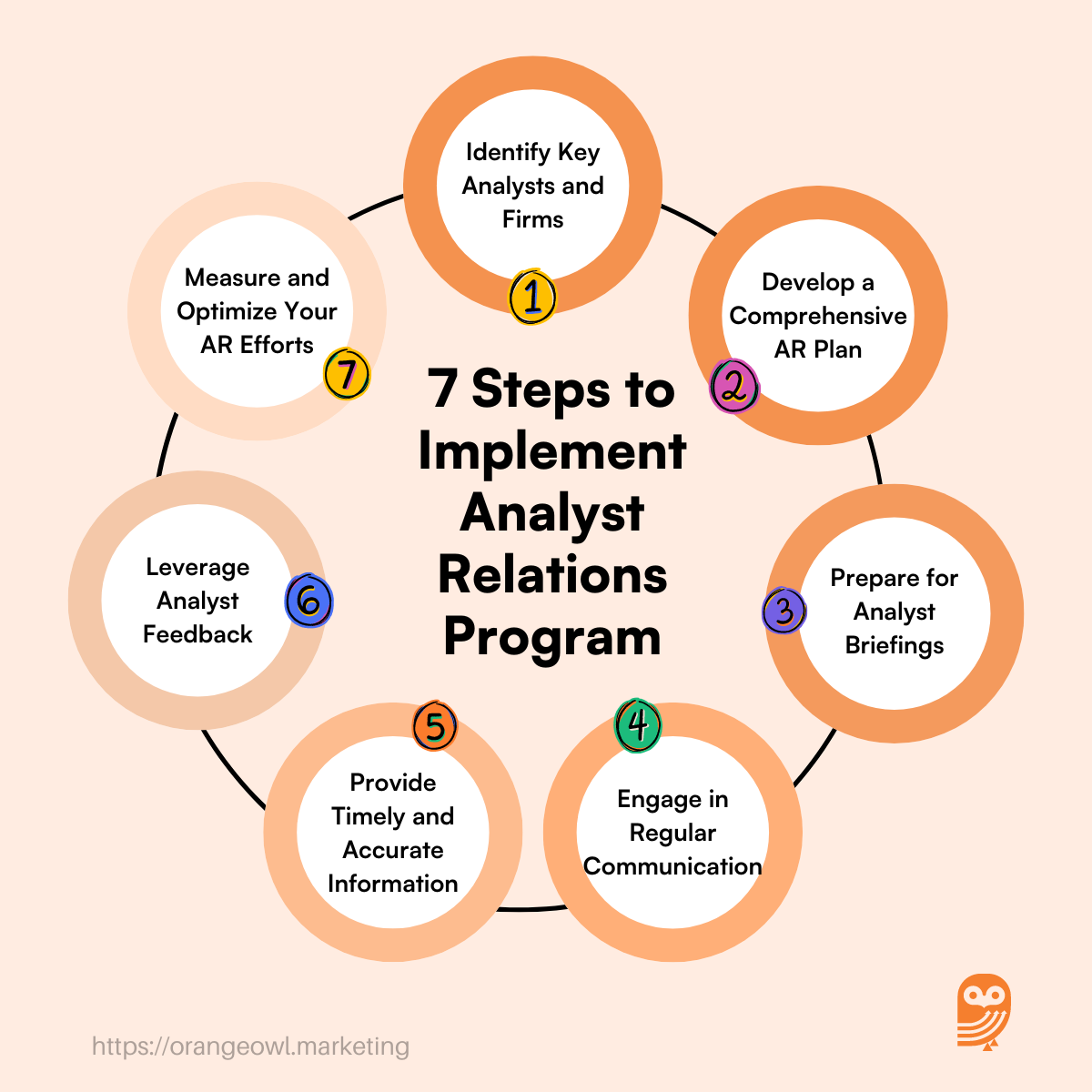The Importance of Analyst Relations in B2B Marketing: A Comprehensive Guide
Vivek Goel
July 17, 2024

Table of Contents
Analyst relations (AR) play a crucial role in the B2B marketing landscape. Building strong relationships with industry analysts can significantly enhance a company’s reputation, credibility, and visibility in the market. This comprehensive guide will delve into the importance of analyst relations in B2B, key benefits, best practices, strategies for successful AR programs, and how to overcome common challenges.
What Are Analyst Relations?
Analyst relations (AR)in B2b involves the strategic management of relationships between a company and industry analysts. These analysts, who work for firms like Gartner, Forrester, and IDC, provide insights and research that influence market perceptions and purchasing decisions. AR aims to ensure that analysts have a clear, accurate understanding of a company’s products, services, and overall market strategy.
Why Are Analyst Relations Important in B2B Marketing?
Analyst relations in B2B are vital for several reasons:
Influence on Buyer Decisions
Industry analysts significantly influence the purchasing decisions of B2B buyers. Their reports, recommendations, and insights are often trusted sources of information.
Market Credibility and Validation
Positive evaluations and endorsements from respected analysts can enhance a company’s credibility and validate its market position.
- Competitive Advantage: Effective AR can help companies understand market trends, competitor strategies, and emerging opportunities, providing a competitive edge.
- Visibility and Awareness: Engaging with analysts increases a company’s visibility in key industry reports, rankings, and events, helping to build brand awareness.
Key Benefits of Analyst Relations
1. Enhanced Market Credibility
Building strong relationships with industry analysts can lead to favorable mentions in reports and research, enhancing a company’s market credibility. For example, being recognized as a leader in a Gartner Magic Quadrant can significantly boost a company’s reputation.
2. Influencing Market Perception
Through consistent engagement, companies can influence how analysts perceive their offerings and market strategy. This perception often translates into positive analyst reports, which in turn influence potential customers.
3. Access to Strategic Insights
Analysts provide valuable insights into market trends, customer needs, and competitor activities. Companies can leverage this information to refine their strategies and stay ahead of the competition.
4. Improved Product Positioning
Feedback from analysts can help companies improve their product positioning and messaging, ensuring alignment with market expectations and customer needs.
5. Increased Sales Opportunities
Positive analyst reports and endorsements can lead to increased sales opportunities, as potential customers often rely on analyst recommendations during the decision-making process.
Strategies and Steps to Successfully Implement Analyst Relations for Your B2B Company
Implementing a successful Analyst Relations (AR) program involves a strategic approach, detailed planning, and consistent execution. Below is a step-by-step guide with detailed instructions, expert tips, and best practices for each step to help you plan and execute an effective AR program for your B2B company.

1. Identify Key Analysts and Firms
Steps:
- Research Analysts and Firms: Start by identifying the top analyst firms in your industry, such as Gartner, Forrester, and IDC. Look for analysts who cover your market segment and have influence over your target audience.
- Use AR Tools: Utilize AR-specific tools like ARchitect or Apollo to help identify and manage analyst relationships.
- Engage Your Network: Consult with your sales and marketing teams to gather insights on which analysts are most referenced by prospects and customers.
Expert Tips:
- Focus on Relevance: Prioritize analysts who have a deep understanding of your industry and can provide valuable insights.
- Monitor Social Media: Follow analysts on LinkedIn and Twitter to stay updated on their latest research and areas of interest.
Best Practices:
- Create an Analyst Database: Maintain a database with detailed information on each analyst, including their focus areas, recent reports, and contact details.
- Regularly Update Your List: Analysts’ coverage areas can change, so periodically review and update your list.
2. Develop a Comprehensive AR Plan
Steps:
- Define Objectives: Clearly outline the goals of your AR program, such as increasing market visibility, influencing buyer decisions, or improving product positioning.
- Identify Key Messages: Develop key messages and value propositions that align with your business strategy and resonate with analysts.
- Create an Engagement Calendar: Plan out your interactions with analysts, including briefings, product demos, events, and report contributions.
Expert Tips:
- Align with Business Goals: Ensure your AR objectives support your overall business and marketing goals.
- Be Consistent: Consistent engagement is crucial for building strong relationships with analysts.
Best Practices:
- Involve Senior Leadership: Engage your executive team in the AR plan to demonstrate commitment and provide high-level insights during interactions.
- Use SMART Goals: Set Specific, Measurable, Achievable, Relevant, and Time-bound goals for your AR activities.
3. Prepare for Analyst Briefings
Steps:
- Develop Presentation Materials: Create detailed presentation materials that clearly articulate your company’s vision, products, market position, and key differentiators.
- Rehearse the Presentation: Conduct rehearsals with your team to ensure a smooth and professional delivery.
- Anticipate Questions: Prepare answers for potential questions analysts might ask about your products, market, and strategy.
Expert Tips:
- Keep It Concise: Analysts have limited time, so make sure your presentation is concise and to the point.
- Highlight Unique Value: Clearly demonstrate what sets your company apart from competitors.
Best Practices:
- Share Real-World Examples: Use case studies and customer success stories to illustrate your points.
- Provide Supporting Data: Include relevant data and metrics to back up your claims and showcase your achievements.
4. Engage in Regular Communication
Steps:
- Schedule Regular Updates: Set up regular briefings and updates to keep analysts informed about your company’s progress and news.
- Share Valuable Content: Provide analysts with exclusive content, such as early access to reports, whitepapers, and product updates.
- Personalize Interactions: Tailor your communications to each analyst’s interests and focus areas.
Expert Tips:
- Be Proactive: Don’t wait for analysts to reach out to you; take the initiative to keep them informed.
- Foster Long-Term Relationships: Aim to build long-term, mutually beneficial relationships with analysts.
Best Practices:
- Use Multiple Channels: Engage with analysts through various channels, including email, phone, social media, and in-person meetings.
- Track Interactions: Keep detailed records of all interactions with analysts to ensure follow-ups and continuity.
5. Provide Timely and Accurate Information
Steps:
- Ensure Data Accuracy: Verify all information shared with analysts for accuracy and relevance.
- Respond Promptly: Quickly respond to analysts’ inquiries and requests for information.
- Update Regularly: Regularly update analysts on significant developments, product launches, and market changes.
Expert Tips:
- Maintain Transparency: Be transparent about your company’s strengths and challenges.
- Avoid Jargon: Use clear and straightforward language to ensure analysts easily understand your messages.
Best Practices:
- Leverage Internal Resources: Work with internal teams to gather and validate information before sharing it with analysts.
- Provide Context: When sharing data, provide context to help analysts understand its significance and relevance.
6. Leverage Analyst Feedback
Steps:
- Gather Feedback: Actively seek feedback from analysts on your products, strategies, and market position.
- Analyze Feedback: Carefully analyze the feedback to identify areas for improvement and strategic adjustments.
- Implement Changes: Use the feedback to make informed decisions and implement necessary changes in your business strategy.
Expert Tips:
- Be Open to Criticism: Treat constructive criticism as an opportunity to improve.
- Show Appreciation: Thank analysts for their feedback and let them know how it will be used.
Best Practices:
- Create a Feedback Loop: Establish a process for collecting, analyzing, and acting on analyst feedback.
- Communicate Changes: Inform analysts about the changes made based on their feedback, demonstrating that their input is valued and impactful.
7. Measure and Optimize Your AR Efforts
Steps:
- Track Key Metrics: Measure the success of your AR program by tracking metrics such as the number of briefings, analyst mentions, and report inclusions.
- Analyze Results: Regularly review your AR metrics to identify trends and areas for improvement.
- Adjust Strategies: Continuously refine your AR strategies based on the analysis to achieve better results.
Expert Tips:
- Use Analytics Tools: Utilize analytics tools to gain insights into the effectiveness of your AR efforts.
- Benchmark Performance: Compare your performance against industry benchmarks to assess your AR program’s effectiveness.
Best Practices:
- Set Clear KPIs: Establish clear Key Performance Indicators (KPIs) to measure the success of your AR activities.
- Regularly Review and Update: Conduct regular reviews of your AR program and make necessary adjustments to stay aligned with your business goals.
By following these detailed steps and incorporating expert tips and best practices, your B2B company can successfully implement an effective Analyst Relations program. This strategic approach will help you build strong relationships with industry analysts, enhance your market credibility, influence buyer decisions, and drive business growth.
Best Practices for Effective Analyst Relations
1. Build and Maintain Strong Relationships
Establishing and maintaining strong relationships with key analysts is crucial. Regular interactions, such as briefings, meetings, and informal conversations, help keep analysts informed and engaged.
2. Provide Valuable Content
Offer analysts valuable content, such as product updates, case studies, and industry insights. Ensure that the information is relevant, accurate, and timely.
3. Be Transparent and Honest
Honesty and transparency are vital in AR. Be upfront about your company’s strengths and weaknesses. Analysts appreciate candor and are more likely to trust your information.
4. Tailor Your Approach
Customize your approach based on the analyst’s interests and focus areas. Understand their research agenda and provide information that aligns with their priorities.
5. Engage Proactively
Don’t wait for analysts to reach out to you. Proactively share updates, invite them to events, and seek their feedback on new initiatives.
Overcoming Common Challenges in Analyst Relations
1. Limited Resources
Many companies struggle with limited resources for AR. To overcome this, prioritize your efforts on the most influential analysts and key engagements. Use digital tools and platforms to streamline interactions and improve efficiency.
2. Differentiating Your Message
In a crowded market, standing out can be challenging. Focus on your unique value propositions and provide clear, compelling messages that highlight what sets your company apart.
3. Managing Expectations
Managing internal and external expectations is crucial. Set realistic goals for your AR program and communicate these to your stakeholders. Ensure that your team understands the long-term nature of building strong analyst relationships.
4. Navigating Negative Feedback
Negative feedback from analysts can be tough to handle. Approach it as an opportunity to learn and improve. Address the concerns raised, make necessary adjustments, and keep analysts informed about the steps you are taking.
5. Keeping Analysts Engaged
Maintaining ongoing engagement with analysts can be challenging. Regularly share updates, invite them to events, and seek their input on new initiatives to keep them interested and informed.
Conclusion
Analyst relations are a critical component of B2B marketing. By building and maintaining strong relationships with industry analysts, companies can enhance their market credibility, influence buyer decisions, and gain valuable strategic insights. Implementing best practices and effective strategies can help maximize the impact of your AR efforts, leading to increased visibility, improved product positioning, and greater sales opportunities. Overcoming common challenges and continuously refining your approach will ensure long-term success in analyst relations. Embrace the power of AR to drive your B2B marketing success and stay ahead in the competitive market landscape.
Top Frequently Asked Questions (FAQs) on Analyst Relations
To identify key analysts, start by researching industry reports, rankings, and publications to find those who cover your sector. Look at the firms they work for, such as Gartner, Forrester, and IDC, and their specific areas of expertise. Engage with your sales and marketing teams to understand which analysts your prospects and customers reference. Tools like ARchitect or Apollo can also help identify influential analysts in your industry. Once identified, prioritize them based on their influence, relevance to your market, and the potential impact they can have on your business.
Keeping analysts engaged requires consistent communication and providing valuable insights. Regularly schedule briefings to update them on company news, product developments, and industry trends. Share exclusive content, such as early access to research, product roadmaps, and case studies. Invite them to participate in webinars, industry events, and user conferences. Personalize your interactions by understanding their interests and providing tailored information. Building a relationship based on mutual value and respect helps maintain long-term engagement.
conducting periodic audits.
Small businesses can leverage analyst relations by focusing on a few key analysts who are most relevant to their market. Start with digital interactions, such as participating in webinars and virtual briefings, which are cost-effective. Use social media to engage with analysts and share your insights. Offer valuable content like unique case studies and innovative product updates. Additionally, small businesses can consider joining industry groups or consortia that facilitate analyst interactions and provide networking opportunities.
An effective analyst briefing should include a clear agenda, starting with an introduction to your company and its mission. Provide a concise overview of your market position, key products or services, and unique value propositions. Share recent achievements, such as major customer wins, partnerships, or product launches. Include detailed information about your market strategy, competitive landscape, and future plans. End with a Q&A session to address any questions and gather feedback. Ensure the briefing is well-structured and provides analysts with valuable, actionable insights.
Analyst reports are highly influential in B2B markets as they provide trusted, third-party evaluations of vendors and technologies. Buyers often refer to these reports during the research phase of the buying cycle to understand market trends, compare vendors, and assess the risks and benefits of their options. Positive mentions or high rankings in these reports can significantly enhance a company’s credibility and influence buyer decisions. Conversely, negative reviews can deter potential customers. Therefore, maintaining a positive presence in analyst reports is crucial for influencing buyer behavior.
Key metrics to track include the number of analyst briefings and interactions, mentions in analyst reports, and the sentiment of those mentions. Measure the impact on sales by tracking leads and deals influenced by analyst recommendations. Monitor changes in market perception and competitive positioning based on analyst feedback. Additionally, track the reach and engagement of any co-branded content or joint webinars with analysts. Regularly reviewing these metrics helps assess the effectiveness of your AR efforts and identify areas for improvement.
Handling negative feedback requires a proactive and constructive approach. First, acknowledge the feedback and thank the analyst for their insights. Analyze the concerns raised and determine if they are valid and actionable. Address the issues transparently, explaining the steps you are taking to resolve them. Keep the analyst informed about your progress and improvements. Use this opportunity to build trust by demonstrating your commitment to continuous improvement. Constructive engagement with analysts can turn negative feedback into a positive relationship over time.
A successful AR plan should include clear objectives, such as improving market perception, influencing buyer decisions, or enhancing competitive positioning. Identify and prioritize key analysts and firms relevant to your industry. Develop a detailed engagement strategy outlining how and when you will interact with these analysts, including briefings, events, and content sharing. Establish key messages and value propositions that align with your business goals. Finally, include metrics to measure success and a timeline for regular review and adjustment of the plan.
AR contributes to the overall marketing strategy by enhancing credibility and visibility. Positive analyst endorsements can be leveraged in marketing materials, sales presentations, and on your website to build trust with potential customers. AR insights can inform content marketing strategies by identifying key trends and pain points in the market. Additionally, AR can support public relations efforts by securing analyst participation in press releases and media events. Integrating AR with broader marketing initiatives ensures a cohesive and impactful approach.
Digital tools play a crucial role in managing analyst relations by streamlining communication, tracking interactions, and measuring outcomes. Tools like ARchitect and Apollo facilitate scheduling and managing briefings, storing analyst contact information, and tracking engagement history. CRM systems can integrate AR activities with broader marketing and sales efforts, ensuring alignment and consistency. Analytics platforms help measure the impact of AR on sales and market perception. Using digital tools enhances efficiency, organization, and the ability to analyze and optimize AR strategies.


